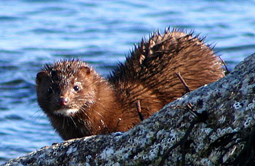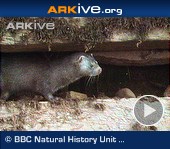American Mink
The American mink is a predator and belongs to the family of martens (Mustelidae). The American mink lives on the shores of naturally structured streams and rivers. It finds shelter in swamps, lakes and on sea shores. Originally from North America, the American mink was brought to Europe in 1920 for its fur. Animals that fled from fur farms ousted the European Mink in only a short period of time. Today, the American mink belongs to the most populous predators in Scandinavia and the British Isles. Grown males reach a body length of approx. 39 cm and females are somewhat smaller, at 34 cm.
Minks spend most of the time in and around water. Swimming and diving are important activities for minks that primarily find their food in the water. They feed on invertebrates, fish, amphibians, birds, and small mammals. Staying in water also protects them from their enemies. Minks occupy territories of 0,5 to 6 km along watercourses. Within these areas, the animals regularly lay back large stretches, use several different dens and bolt holes as well as climbing trees.
Minks are pronounced loners. They defend their territory against intruders and react very aggressively against other adult minks. They use their excrements or secretion from their scent glands to mark their territories. Thanks to their excellent sense of smell, they react quickly to odor markings and are able to distinguish between different individuals.
Minks do not form couples. During mating season, from February to March, the males attempt to mate with various females who then have 3 to 7 kits that they feed for 5 to 6 weeks. The young, however, stay with their mother beyond this period. It is only during these periods and in these formations that minks live in social groups.
Minks are afraid of people.


